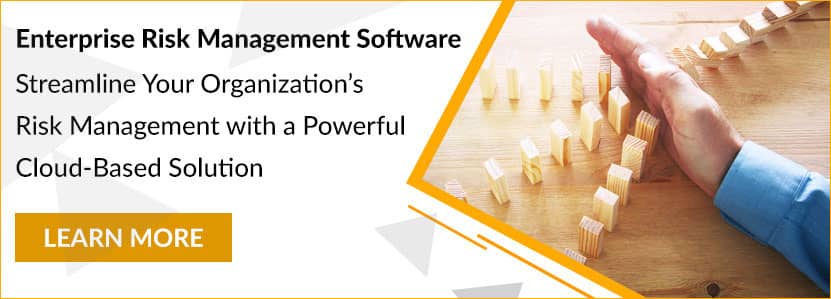Home/ Blog / How Compliance and Risk Technology Enhances Collaboration Throughout the Organization
Employees at various levels within the organization have diverse responsibilities regarding risk and compliance management. Still, each of them must perform their assigned duties to minimize risks and assure compliance successfully. When risk and compliance technology was first introduced, it was confined to a few functions and was used by a single department within the firm. The technology has advanced to the point that risk and compliance platforms can now support a variety of workflows for various departments inside the business. This evolution of the compliance and risk technology platforms enables the organization to manage risk and compliance more effectively and efficiently.

A three-lines-of-defense approach is frequently utilized in the risk and compliance areas. The first group consists of employees who directly interact with customers; the second group consists of employees who are responsible for risk and compliance management within the organization, and the third group consists of the internal audit team. The entire framework is rounded off by a 4th group that is not directly involved in the risk and compliance processes but still has oversight over everything – the executives and board members who are ultimately responsible for running an organization that places a premium on risk.
Understanding the distinct roles that each of these three groups must play in the risk and compliance domains is crucial for any organization seeking to improve its risk management and compliance management practices.
The Front Line
Ideally, the first line of defense is where most firms would like to discover and handle risk and compliance issues. However, this is where inherent risk of compliance or risk management concerns re introduced within the firm. The first line of defense is designed to assist the organization in growing its client base and expanding its business by encouraging customers to use the financial institution’s services.
Risk management and compliance might cause delays in their workflows, reducing their productivity and contribution to the firm. If they attempt to work faster, the likelihood that they may overlook something connected to risk or compliance management increases.
Risk and compliance technology platforms are crucial to the workflow of the first line of defense because they automate several risks and compliance procedures and provide personnel with an easy-to-use interface that enables them to comply with regulations and manage risks swiftly and efficiently. In other words, risk and compliance technology platforms enable the first line of defense to focus on their specific position inside the organization while also managing risks and compliance effectively. In many cases, they increased their productivity because they could work faster and offload many repetitive jobs that were previously done manually to robotic process automation within the organization’s risk and compliance management platform.
The 2nd Line of Defense
Risk and compliance management divisions inside a business operate differently from the rest. The significant differentiation is that risk and compliance are their primary focus. These departments benefit from risk and compliance management tools that make it easier to more efficiently monitor activities across the enterprise. Rather than contacting the other departments and requesting risk and compliance information for analytics and reporting, risk and compliance management teams can access their risk and compliance technology platform. They can detect issues more quickly, report them instantaneously, and automate notifications for follow-up on corrective measures.
The evolution of the compliance and risk technology platforms enables the organization to manage risk and compliance more effectively and efficiently. Share on XWithin a corporation, both the risk and compliance teams fulfill vital functions. Without a risk and compliance management platform, the risk and compliance framework exist solely on paper or in the heads of risk and compliance personnel. When a risk and compliance platform is adopted within an organization, the framework becomes digital, allowing risk and compliance teams to concentrate their efforts on its operation. They not only have more time to concentrate on more significant risk and compliance initiatives, but they also have increased mental capacity to manage risk and compliance processes, as the organization’s digital software platform now handles all manual activities and the framework.
The Internal Audit
The internal audit team is ultimately responsible for auditing the entire risk, compliance, and governance framework to determine its efficacy. Risk and compliance technology makes their work easier. The internal audit team must go through the workflows of other departments, their documents, and get the data needed for auditing. Risk and compliance technology platforms make all this information easily accessible for the audit team. The audit trails created within the platform aid the audit team in quickly discovering root causes and implementing corrective actions.
The Executive Oversight
The executive management and the financial institution’s board are ultimately responsible for running an organization that ensures compliance and manages risks. The problem is that while they have this great responsibility, they have no great power to influence risk and compliance directly. They rely on reporting done by other departments and the risk and compliance departments to assess the risk and compliance framework.
Risk and compliance technology give the executive line direct visibility and control over the risk and compliance framework. They can follow key risk indicators and compliance metrics via dashboards and intervene when needed.
Risk and compliance technology are no longer confined to just being a tool for a specific case. There are now platforms that help different employees across the organization fulfill their responsibilities—interested in seeing how your organization can benefit from risk and compliance technology? Our platform Predict360 has been endorsed by the American Bankers Association (ABA) for risk and compliance management. Get in touch with our team to see what Predict360 can do for your organization.
Request a Demo
Complete the form below and our business team will be in touch to schedule a product demo.
By clicking ‘SUBMIT’ you agree to our Privacy Policy.




